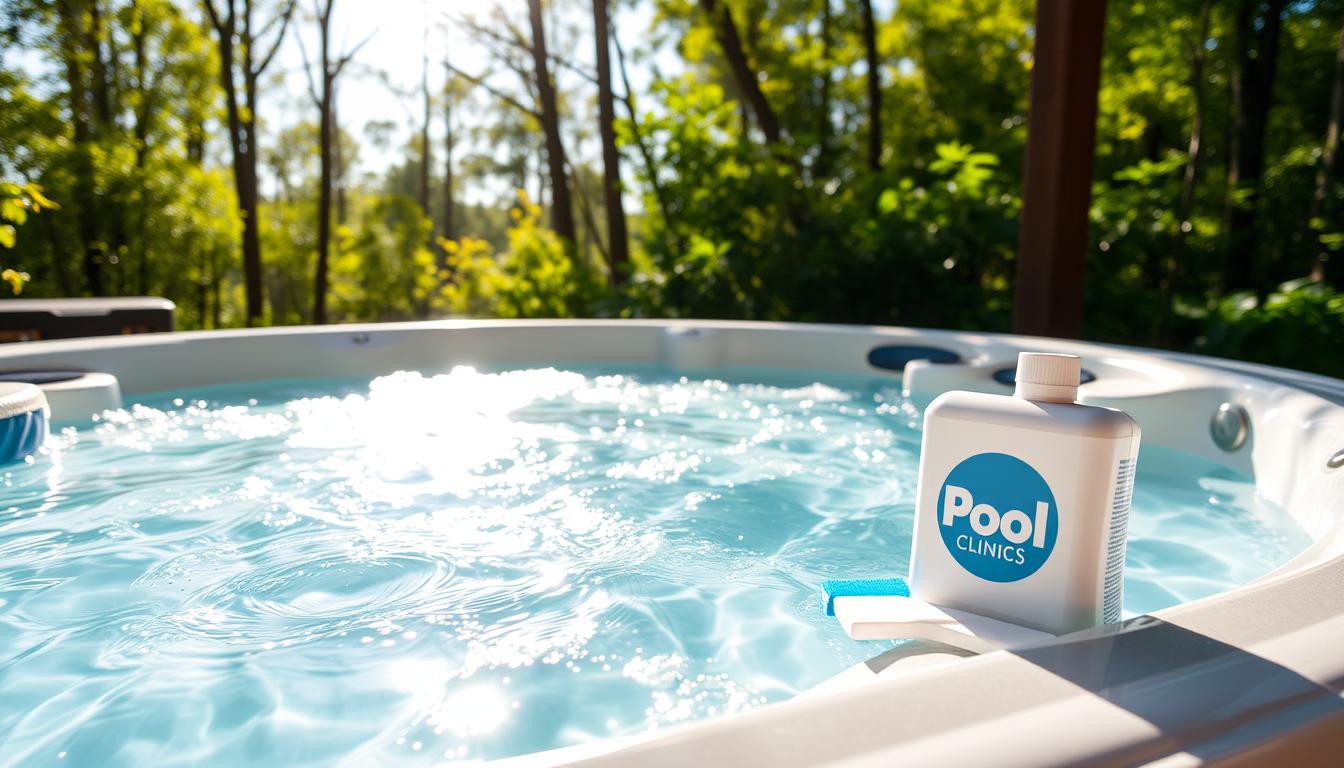
Keeping a hot tub clean is crucial for a healthy soaking experience. Dirty water can breed harmful bacteria, leading to skin infections and health issues. Let’s explore proven methods to eliminate bacteria and keep your spa water safe.
We’ll share effective solutions for hot tub disinfection and water treatment. Our guide covers sanitizers, shock treatments, and cleaning routines to maintain crystal-clear water.
This article delves into common hot tub bacteria and their health risks. We’ll highlight signs of contamination so you can act quickly. Our step-by-step guide will help you tackle bacterial problems effectively.
You’ll learn to maintain proper water chemistry and establish a regular cleaning routine. We’ll also cover hygiene practices for hot tub users and effective sanitization techniques.
Key Takeaways
- Maintain proper water chemistry with ideal pH, alkalinity, and sanitizer levels
- Establish a regular cleaning and maintenance routine, including weekly filter cleaning
- Encourage proper hygiene practices for hot tub users, such as showering before entering
- Utilize hot tub shock treatments to effectively kill bacteria and maintain water quality
- Regularly test and adjust water chemistry to prevent bacterial growth and contamination
Understanding Hot Tub Bacteria and Its Risks
Hot tubs are perfect breeding grounds for bacteria. Warm, moist conditions help them thrive. Knowing the signs of bacterial growth helps us keep our hot tubs clean and safe.
Common Types of Bacteria Found in Hot Tubs
Legionella and Pseudomonas are two dangerous bacteria found in poorly maintained hot tubs. These can cause serious health issues if left unchecked.
- Legionella bacteria can cause Legionnaires’ disease, a severe form of pneumonia that can be life-threatening, as well as Pontiac fever, a milder flu-like illness.
- Pseudomonas bacteria can lead to various infections, including skin rashes, eye and ear infections, and even pneumonia.
Health Risks Associated with Hot Tub Bacteria
Hot tub bacteria can cause various health problems. People with weak immune systems, lung disease, or older adults are at higher risk.
| Risk Factor | Description |
|---|---|
| Age | People 50 years of age or older are more susceptible to Legionnaires’ disease. |
| Smoking | Current or former smokers have a higher risk of contracting Legionnaires’ disease. |
| Chronic Lung Disease | Individuals with chronic lung conditions are more vulnerable to bacterial infections. |
| Weakened Immune System | People with compromised immune systems, such as those undergoing chemotherapy or taking immunosuppressive medications, are at increased risk. |
Avoid breathing in mist from hot tubs. It may contain harmful Legionella bacteria that can cause respiratory infections.
Signs of Bacterial Contamination in Your Hot Tub
Knowing the signs of contamination helps maintain a healthy hot tub. Watch out for these warning signs:

- Cloudy or discolored water
- Foul odors emanating from the water
- Slimy or sticky surfaces, indicating the presence of biofilm
- Excessive foaming of the water
- Skin irritation or rashes after using the hot tub
Act quickly if you spot these signs. Test water chemistry and maintain proper disinfectant levels regularly. Clean and maintain your hot tub thoroughly to eliminate germs.
Effective Methods to Eliminate Hot Tub Bacteria
Keeping your hot tub clean and healthy is crucial. We’ll explore ways to eliminate bacteria through proper water chemistry, regular maintenance, good hygiene, and shock treatments.
Maintaining Proper Water Chemistry
Balanced water chemistry prevents bacterial growth in your hot tub. Test and adjust pH levels to 7.2-7.8. Keep alkalinity at 80-120 ppm.
Maintain chlorine at 3-5 ppm or bromine at 4-6 ppm. This balance creates an environment unfriendly to harmful bacteria like Pseudomonas aeruginosa.
Establishing a Regular Cleaning and Maintenance Routine
Consistent cleaning is key to a bacteria-free hot tub. Remove debris, brush surfaces, and clean or replace filters regularly. Drain and refill every 3-4 months, depending on use.
A regular maintenance schedule prevents organic matter buildup. This keeps your hot tub in top condition and reduces bacterial growth.
Encouraging Proper Hygiene Practices for Hot Tub Users
Good hygiene prevents bacteria spread in hot tubs. Ask users to shower before entering to remove contaminants. Advise against using the tub with open wounds or illness.
These habits maintain a cleaner, healthier environment for all to enjoy.
Using Hot Tub Shock Treatments
Shock treatments effectively eliminate bacteria and contaminants in hot tub water. They work by oxidizing water and boosting sanitizer effectiveness.
Follow manufacturer instructions when using shock treatments. Test water before and after to maintain proper chlorine or bromine levels.
| Parameter | Recommended Range |
|---|---|
| pH | 7.2 – 7.8 |
| Alkalinity | 80 – 120 ppm |
| Free Chlorine | 3 – 5 ppm |
| Total Bromine | 4 – 6 ppm |
These methods create a safe, enjoyable hot tub environment. Our 35 years of experience and 4.9/5 Google rating back these water care techniques.
Conclusion
Keeping your hot tub free of bacteria is vital for everyone’s health. By understanding the risks and using proper care, you can ensure a safe spa experience. Regular maintenance helps eliminate harmful microbes and keeps the water clear.
A thorough hot tub care routine includes balancing water chemistry and cleaning regularly. Encouraging good hygiene and using shock treatments are also important. These steps work together to create a clean, inviting spa environment.
Stay proactive in your hot tub maintenance and seek expert help when needed. With consistent care, you’ll enjoy a worry-free space to relax. Your family can create lasting memories in a clean, safe hot tub.







